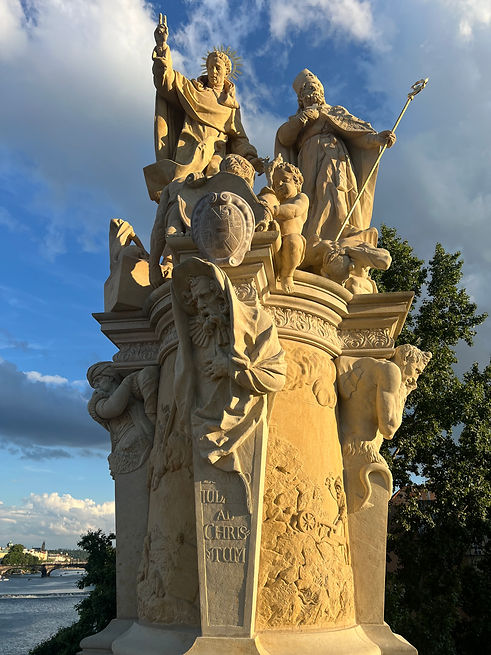Jewish Prague

The city of Prague has long been a cultural center of Judaism in Europe. Since the early medieval era there were Jewish settlers, residents and travelers who found a home in this city along the Vltava River. Like most city centers, Prague had its Jewish Ghetto, outbreaks of antisemitism mixed with a tenacious scholarly and artistic milieu. In the summer of 2024 we had the opportunity to travel to the capital of the Czech Republic and explore some of the vestiges of a once thriving Jewish population.
Our journey began with a delightful four hour trip south from Berlin. Our 6 person compartment was occupied with a pair of sisters from Norway and a young couple from Denmark. The hours of travel were compressed by animated and engaging conversation. Upon arriving by train we were at once reminded by the tragic and heroic legacy of Jewish Prague.
While looking for an exit from the main station we walked by a memorial to Nicholas Winton. The story of Winton is one of the most heartening stories of personal conviction. In the span of one month in Prague, in January, 1939 Winton was able to rescue 669 children from the clutches of the Nazis. The story has just recently been made into a full length movie called, One Life , staring Anthony Hopkins and Helena Bonham Carter.
One of the first places we visited was the Jewish Quarter, easily found on the northwest corner of the Old Town. Wonderfully preserved, but sadly absent of many residents, the Ghetto captures this once vibrant and compact city within a city. The many synagogues and town hall capture hundreds of years of religious and cultural life.
A delightful story that originates in Jewish Prague is the Golem. Based on a story by the local Rabbi Judah Loew, the Golem was a superhuman figure who protected the Jews of Prague. Folktales and rumors filled the alleyways and imaginations of the denizens of Prague. Even the author of the Lord of the Rings, JRR Tolkien, was inspired by this mysterious superhero.
In light of the Holocaust and the antisemitism of the Soviet era, it is remarkable that there are so many artifacts of Judaism in Prague. Some of the most prosaic yet holy are the many well preserved cemeteries. The Old Jewish Cemetary dates back to 1439 and contain graves up to 12 layers deep. Their jagged and tipping tombstones make for an eerie visit.
A few blocks north is situated a small park with an enigmatic statue of Moses. Rather than the exultant law giver triumphantly holding the Ten Commandments, this Moses writhes on the ground. The sculptor,
František Bílek, made the sculpture in 1905. During the Nazi occupation, the statue was removed and subsequently melted for armaments. Fortunately, after World War II, in 1946, it was again re-cast using the original plaster model. It is both arresting and inspiring.
There is much more to discover and learn about Jewish Prague. An excellent book that surveys the past century is “The Last Palace” by Norman Eisen. It is a lively biography of Villa Petschek and its builder, a Jewish industrialist of the early 20th century.
Our brief stay in Prague gave us a tantalizing taste of the rich history of Judaism in this part of Central Europe. Prague has many tours of Jewish sites and symbols if you have the opportunity to travel there. For a reading list click HERE for suggestions. A Cathedral Tours trip is scheduled for October, 2025 for an in depth visit to Prague and all of Bohemian Europe!
